This survey is performed to assess the technical condition of the foundation and soils of the base of operating buildings, as well as, in the case of an increase in the load on the foundation and the base from the built-up floors, replacement of floors, an extension to the existing building of additional volume. It is also mandatory to inspect the foundations in the presence of defects in the building structure, indicating subsidence, uneven settlement of the building. In the case of a new building being built next to a single existing building, or next to a group of buildings.
When examining foundations and foundations it is obligatory to study the materials previously performed by geotechnical investigations in this or in a neighboring area (if any). Study of the results of previous surveys about the technical condition, the depth of the foundations, the repair work performed.
Directly a pit is being opened at the facilityin near foundations, for study current state grounds, soil samples are taken and groundwater under the sole of the foundation, testing of soils with static loads. The type, design and depth of the foundations, the degree of improvement and the condition of the building blind area are determined. Instrumental control determines the physical and mechanical characteristics of materials, fixes foundation defects, the state of waterproofing. The correspondence of the current characteristics of the engineering-geological state of the foundation soils and the groundwater level to the archive data is determined.
Based on the survey results measures are determined for the need to strengthen the foundations. In the event of an increase in the volume of a building due to an additional load and in the event of detection of defects, the bearing capacity of the foundation soils is determined by a verification calculation to accommodate the existing and additional load.
The main provisions for the survey of foundations are contained in section 5, GOST R 53778-2010 “Buildings and structures. Rules for inspection and monitoring of technical condition. "
An example of a survey of the foundations of a building.Determination of the state of the foundation for the existing load.
When conducting a survey the foundation of the building was examined, its structure and condition were determined. Soil samples were taken from the pits for examination in the laboratory. To determine the loads on the base, the structure and composition of floors, building walls, roof structures, and roofs were determined. On the basis of examinations in the laboratory, the physical and mechanical properties of soils were determined.
Measurements of structures were made, in some places, probes were made to determine the structure and composition of the floors and floors on each floor, the loads from rafter system and roofs. According to the results of the survey, design resistance base, a verification calculation of the base under the base of the foundation for the perception of the existing load has been determined, maximum draft grounds. Based on the results of the survey and verification calculations, it was determined that the bearing capacity of the foundation was provided for the perception of the load transmitted from the base of the foundation. Draft within the limits of norms SNiP.
Based on the survey results of the technical condition of the foundation structure, it was found that the foundation has defects in the form of washing out the destructed mortar from the seams of the masonry. Horizontal waterproofing does not provide protection against moisture capillary suction from the soil. The blind area, in places, is destroyed, the slope of the layout, in places, is directed towards the building, surface water penetrates to the foundation.
The findings of the inspection are:
- The bearing capacity of the foundation for the perception of the existing load is ensured, reinforcement is not required, but, due to unorganized drainage from the foundation of the building, soil soaking can lead to uneven settlement of the building.
- It is necessary to take measures to eliminate the penetration of surface water to the foundation and base of the building. To do this, it is necessary to arrange a blind area with drainage trays at the locations of drainpipes, to replace drainpipes with new ones, with the organization of the direction of discharge from the drainpipes to the trays of the building blind area.
- In view of the identified defects in the foundation of the building, the bearing capacity of the foundation will be ensured only after measures to strengthen brickwork foundation. It is recommended to make reinforcement by injection or by means of a reinforced concrete frame.
- Produce a shut-off device horizontal waterproofing along the perimeter of the building, at a height of at least 150mm, from the top of the building blind area.
The foundation is the foundation of the house. It depends on him how durable the structure will be. It takes on the bearing load, evenly distributing it over the ground. Therefore, when buying a finished home, it is important not only to look at the layout and material of the walls, but also the condition of the base. This is most important for old houses. The article will discuss how to conduct a foundation survey.
To determine the degree of wear of the base of the building, you need to conduct a survey. The main cases when it is important to do this:
- during capital repairs of the house;
- during reconstruction, which will inevitably lead to an increase in the bearing load on the foundation, for example, when adding floors;
- if you find visible defects such as cracks or a tilt in the house;
- or when extensive excavationthat could affect the bearing capacity of the soil or the foundation itself;
- after natural disasters such as landslides, landslides, severe floods or seismic soil vibrations.
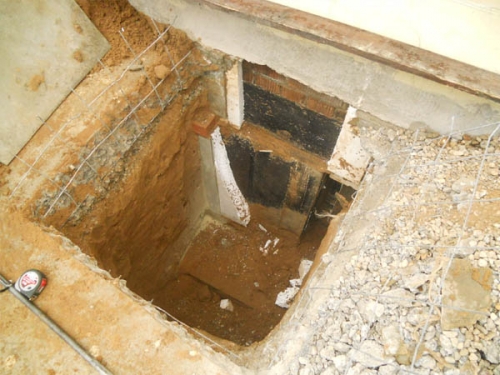
In most cases, a foundation survey is ordered by special companies that conduct a professional examination of all hidden foundation elements. This is a responsible and time-consuming process that requires professional knowledge and expensive equipment. Therefore, in the case of apartment building it is unrealistic to independently assess the current state of the foundation. But it is quite possible to conduct a survey of the foundation of a small country house.
Increasingly, people are trying to escape from the bustle of the city, buying houses in villages and cottage settlements. There is not always a desire or opportunity to build a house on your own or to track all stages of construction. Therefore, this real estate market is replete with proposals for the sale of homes. And here you have to be especially careful. It is not uncommon for houses originally built for sale to have foundation problems after the first winter. As well as old buildings, the foundation of which has fallen into disrepair due to prolonged use without proper maintenance.
Advice: when buying a house, you need to clarify how deep the groundwater is. If they are nearby, then the foundation should not have not only a basement, but also storage pits. In winter, the water accumulated in the depression will freeze and expand, this will inevitably lead to cracks in the foundation and masonry of the walls.
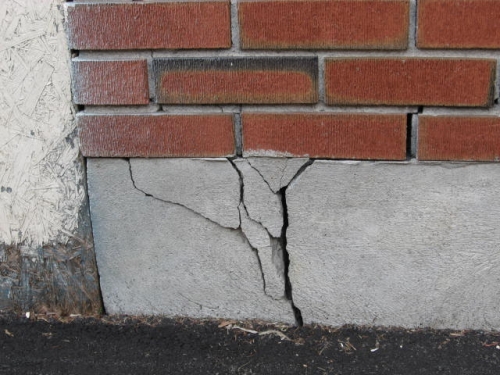
The reasons due to which the foundation is destroyed
- Unfinished construction, which was stopped for several years. In particular, concrete base will become unusable in the absence of a blind area, drainage system and drainage wells. That is, everything that is responsible for water drainage.
- Departure from calculations. During construction, in the house plan, all the calculated data are indicated, according to which the technological process is formed. And if a cheaper grade of concrete or the wrong diameter of the reinforcement was chosen, the foundation will not be durable either. Another reason is often the lack of time, due to which the concrete mixture is not allocated for setting. the required amount time.
- Reconstruction work was carried out illegally inside the house, increasing the load on load-bearing walls... Or, which happens quite often, the transformation of the attic into a residential floor.
- The constant strong vibration is also detrimental. This applies to crowbars located in the immediate vicinity of railroad or the autobahn.
It is rarely possible to take into account all these factors in advance; sometimes they are rather unpredictable. Therefore, you should pay close attention to the foundation at the slightest suspicion. Unfortunately, most country houses have a decorative facing of the foundation with a stone or corrugated board, therefore, it is already possible to see the obviousness of the problem at a critical stage.
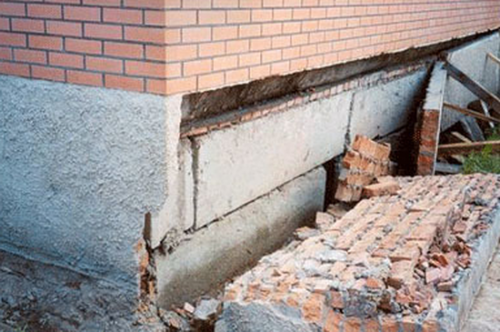
In addition, strong deformations of the base often occur due to natural features at the construction site. And if in the first years there were no changes, then this may manifest itself in the following. These include:
- atmospheric precipitation, which freely penetrate to the foundation, soaking it;
- flooding of the basement with sewage water or due to leaking water pipes;
- spring groundwater rises above the permissible value;
- weak ground. For example, when filling a plot, he was not allowed to stand for a year and immediately began to build a house;
- leaching of soil during a flood or, in the absence of insulation of the foundation, its freezing in winter.
The main technique for examining foundations is boring. In the process of work, samples of soil, concrete, mortar or stone are taken for research in special laboratories. And also conduct a visual inspection. There are times when it is required to partially destroy the base in order to check the condition of the reinforcement. But, for the most part, this applies to apartment buildings; you will not need to do this in a private small house.
Inspection of strip or columnar foundation
The tape is made in the form of a monolithic tape around the perimeter of the house and under its load-bearing walls. And columnar, as the name implies, in the form of free-standing pillars connected by a concrete or wooden grillage. Most often they are made of reinforced concrete, but these structures are also made of brick, rubble stone or concrete foundation blocks. View building material and defines the technological process for examining the base.
The main criteria by which the quality of tape and columnar foundation:
- using a laser level check horizontality bases along the entire length of the wall. The usual building level for these purposes will not work, since there will be a large error;
- visually inspect for the presence cracks... It may be necessary to disassemble the facing and thermal insulation layer for this;
- when examining concrete strip foundation shouldn't show up protruding reinforcement, large chips or delamination of the composition;

- the brickwork should look good on a brick base. With signs destruction of masonry mortar and waterproofing layer, and in the absence of bricksrepairs will be inevitable;
- block or stone foundation when destroyed, they can shift, they will immediately be noticeable protrusions of individual blocks or their significant chips.
The most economical is considered to be a columnar foundation made of brick. It is often used for secondary buildings with low mechanical stress. Therefore, the technological process is often overlooked. But because of this, they are more likely to be destroyed and repair work... It should be checked at least once a year in the spring. It is enough just to determine the vertical of the pillars along the perimeter with a plumb line.
Technical inspection of slab and columnar-strip foundations
- Slab foundation is a monolithic reinforced concrete slab poured under the area of \u200b\u200bthe entire building. Depending on the expected load, a pit breaks out under it. Inspection of such a base consists in an external examination for the presence of cracks or severe mechanical damage, as well as for the evenness of the axes (first of all, the skew of the entire slab should be excluded). It is important to check the integrity of the waterproofing and the quality of the external bedding.

- Columnar-tape the foundation is a reinforced concrete tape, which, after a certain step, is reinforced with pillars poured below the freezing level. During its construction, they first dig a trench around the perimeter of the house and inside, under the future load-bearing walls. And then, wells are drilled 1.5-2 m deep and reinforcing bars are inserted into them. They are not equipped for sand pillow, and immediately poured with concrete. As a rule, these pillars are a strong link and additionally strengthen the foundation, so they do not need to be examined.
Visual inspection of foundations and foundations
There are many methods and devices for checking foundations. Many of them require professional knowledge, extensive excavation work and considerable financial investments. But there is an accessible and easy way for everyone - visual inspection. It is quite effective and sometimes only it is enough to assess the current state of the foundation.
The best time for a visual inspection of the foundation is spring. After going through the freeze / thaw cycle, the foundation will show itself to the greatest extent. This is where the flaws that were made during the construction, but were invisible, appear.
Important: sometimes it happens that problems begin in winter. For example, when the columnar foundation of an extension to the main house freezes, it can raise the building. As a result, the porch or veranda is simply warped. It is easy to notice this even without examining the foundation, since the front door stops opening easily and rests on the floor. To avoid this, you need to make a blind area and insulate the foundation.
Stages of visual inspection in spring:
- they begin with a survey of the soil around the foundation. It is bad when it partially subsided or even failed. Most likely, the cause was melt water, which washed away the soil. And this means that the blind area was made with violations or is completely absent. Such holes must be urgently filled and tamped;
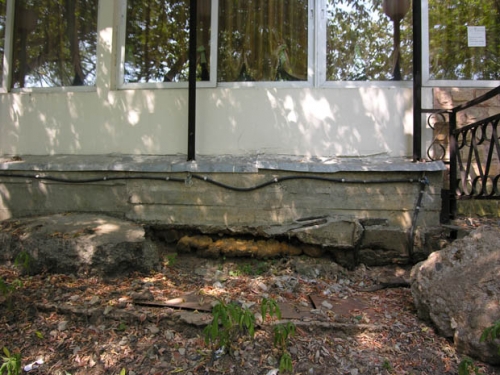
- when the base is covered with decorative cladding and it is not possible to track its condition, the walls of the house and window openings themselves are examined. The presence of skew is determined by the windows, and there should be no cracks on the walls that could appear as a result of deformation of the foundation;
- in the presence of a basement, inspect the quality of the waterproofing layer. Salt deposits will indicate its damage. white on the walls of the basement or cellar. Over time, this will lead to constant dampness and mold in the house itself, and then the destruction of the concrete base will follow;
- even at the stage of pouring concrete solution, it must be tamped in order to remove air bubbles and reduce its porosity. Sometimes this point is missed, which leads to a decrease in strength and further cracking. If, upon visual inspection, cracks were found on the foundation itself, then an inspection for the presence of such pores may reveal the situation. Ideally, its surface should be absolutely smooth;
- an important step is the arrangement of a sand cushion. When not done, heaving can literally push the foundation out of the ground. Therefore, an undercut is made along the outer or inner wall of the base to its base to make sure that it is there.
When all the above methods have been carried out, but there are still doubts about the quality of the foundation, it is worth inviting specialists. He has in his arsenal a whole list of special tools that are inaccessible to ordinary people and incomprehensible to use. In addition, a laboratory examination may be required.
Building Foundation Inspection Tools
- For checking concrete or screw piles there is a special hammer for the "dream book" method... It is often used due to its compactness and ease of use. With its help, a so-called express inspection is carried out, which reveals possible cracks in monolithic construction or the inclusion of soil in bored piles.
- The principle of operation is seismic spectral flaw detection. For this, a hammer is struck on the top of the pile, and then the wave is reflected and transmitted to a laptop. If the pile has no cracks, then the device will accurately show its total length. If there are defects, the wave will break on it.
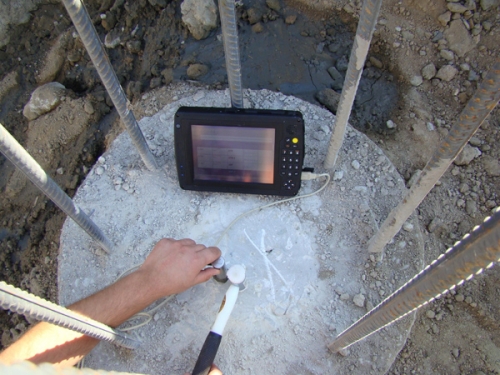
- Thus, for the survey, you will not need to disassemble the structure, carry out expensive earthworks, and the result will be absolutely accurate without human error. This example is often used not only for piles in the foundation, but also for detecting deformations of the bearing columns of buildings, floor slabs, etc.
- Also suitable for inspection is a regular building level, which more accurately than "by eye" determines the vertical and horizontal of the support pillars. For tape or monolithic foundation more convenient and expedient to use laser level, the measurement length of which is practically unlimited.
- The most effective and common way to inspect foundations during reconstruction is device of special pits... This method will most accurately show the condition of the foundation and the possibility of maximizing the load on it. We will describe this process in more detail below.
Foundation survey using pits
- A pit is a small hole that is dug close to the foundation wall. Their location is determined in each case individually and depends on a number of factors. For example, it is worth equipping them exactly in the places of the most noticeable deformations, and also taking into account that they do not interfere with the passage or passage of cars.
- In some cases, it is advisable to dig even in inconvenient places, but all these activities are temporary and, in the presence of a large number of workers or special equipment, they are carried out quickly.
- In addition to pitting places with obvious flaws, they are made on the sections of the foundation that are subject to the greatest stress, and if the house consists of several separate foundation sections, then on each of them.
- For the greatest reliability, the pit is made in a place and deformation and nearby, where the state of the foundation does not cause concern. The data obtained is analyzed and compared.
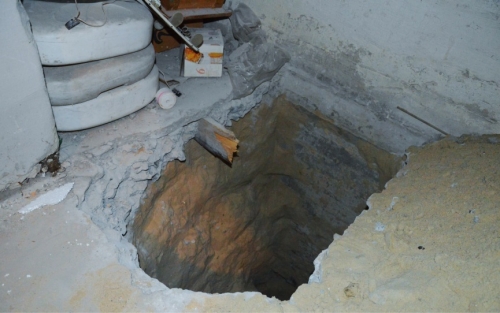
Advice: with a partial superstructure, it is sufficient to check only the part of the foundation located under the future construction work. And with a complete reconstruction of the building, the entire base area is examined.
- If the inspection of the foundation is carried out for preventive purposes, then 2 control pits are organized. With the most severe deformation, it is often recommended to make them from both sides (outside and inside the basement).
- They are dug out quite deep, 50-80 cm below the level of the sandy foundation cushion or the level of screwing in the screw pile. When there is enough space, the walls of the pit are made to slope, for maximum convenient work, in cramped conditions they need to be strengthened with wooden shields and additional struts.
- The process becomes cheaper and much easier when the house has a foundation. You will have to dig less from the inside, and the area of \u200b\u200bthe pit is also reduced.
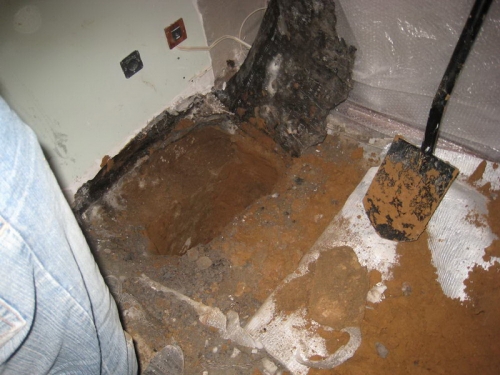
The drilling method reveals the following parameters:
- the depth of the underground part of the base;
- compliance of the width and height of the foundation with those indicated in the design documentation;
- the presence of structural defects and other damage;
- the class of the concrete mixture used when pouring or the grade of the stone;
- vertical deviation;
- the presence of additional reinforcements or previously carried out repair work;
- the quality of the waterproofing layer.
Columnar foundation pitting
There may be several options for the location of the pits:
- on two adjacent sides;
- angular (in this case, the sides are not completely dug out, but only the corner part);

- along the entire perimeter (3 sides are dug out completely, and the fourth is only partially).
If we are talking about a residential building, and not an economic check, then surveys with the help of a pit can only be entrusted to a specialized organization. Before starting work, they make a visual inspection, check with the project documentation. On the basis of all this, a plan is made with the designation of the locations of the pits and their sizes. The presence of professionals guarantees:
- the work will be carried out quickly, which will prevent flooding of the foundation or erosion of the sand cushion in the excavation pestle;
- at the end of the work, the soil will be fully returned to its place and rammed, which guarantees protection from further subsidence of the earth in this place and the collapse of the blind area;
- on the spot, a professional foreman will be able to change the dimensions of the pit himself, for a more reliable examination;
- collection of the necessary samples of the required quality.
Disadvantages of the drilling method
This is a number of inconveniences that will be an integral part of digging holes.
- Before going deeper, you will have to destroy the blind area in this place or the concrete floor, in the case when they are digging from the basement side. Then you will have to carry out restoration work.
- Lots of dirt and concrete dust that will stand in the air.
- Due to the fact that part of the base is exposed, moisture may increase in the basement. Therefore, if there are living quarters in it, it is recommended to remove all the furniture and, if possible, insulate the pit with foil.
- If it starts to rain heavily, the likelihood of flooding is not excluded. You need to keep the pump ready for timely pumping of water.

- The waterproofing layer will inevitably be damaged.
But all these disadvantages and inconveniences are temporary and not so important to abandon this method of studying the state of the foundation.
Inspection of pile foundations
- When buying a house built on screw piles, the foundation survey will be slightly different. Everything here will depend on whether the house is supposed to be reconstructed with subsequent load on the foundation. If so, then it is necessary to examine it. If not, then the quality and reliability of modern screw piles is at the level that you can not worry about their condition in the ground (the exception is cheap handicraft piles with a welded tip, they often begin to rust quickly).
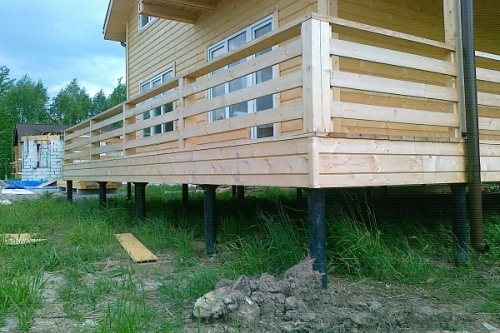
- To inspect the pile-screw foundation, you cannot do without special devices. But the catch is that the domestic devices produced at the Chelyabinsk plant for these purposes are not only very expensive, but they are not certified by Gosstroy. In addition, according to the reviews of professionals using them, they are not effective enough in detecting defects.
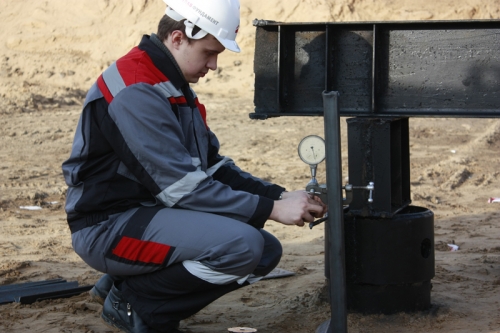
- The permissible load on each pile can be calculated theoretically. But for this you need to know exactly three components: the length of the pile, its cross-section and the geological data of the soil in a particular place.
- The only official recommendation that is given for testing such piles is to remove it from the ground and break it out of the grillage for testing. But if the house is residential and eviction for the period of work is not possible, then this method should be rejected. Indeed, if the foundation already receives the maximum permissible load, the removal of one support for analysis can lead to overload and serious consequences. In addition, piles of several types are often used for the construction of one building, each of which needs to be investigated.
The importance of technical inspection of foundations and base soils
The foundation of a building or structure lays the foundation for the success of the entire construction. In the estimate documentation, the construction of the foundation is about 20% of the total. If it is necessary to strengthen the structure and increase bearing capacity, the cost of work rises to 50%. Such values \u200b\u200bare due to the importance of the work carried out and the specifics of their implementation: high complexity, frequent use of manual labor, compressed space for work.
After the construction of the foundation or when deciding on the reconstruction of the building, an obligatory step is to conduct a survey of the foundation. It is especially important to perform a set of survey work at the proper level before increasing the load on the base (construction of additional floors, increase in the load on the floors).
Features of defects and damage to bases and foundations
Defects in the construction of foundations and foundations can be detected in two stages:
- Under construction.
- At the stage of operation of a building or structure.
In both cases, their occurrence can be prevented by performing necessary work on the prompt detection of deformations. The earlier a problem is detected, the easier it is to fix it.
The main difficulty that arises during the examination of the underground parts of the building is the lack of the possibility of visual control over the state of the element. The foundation is hidden from view and it is not possible to detect defects. Therefore, unique technologies are used to inspect the foundations of buildings. Monitoring the condition and assessing the quality of the structure are mandatory during construction and further operation.
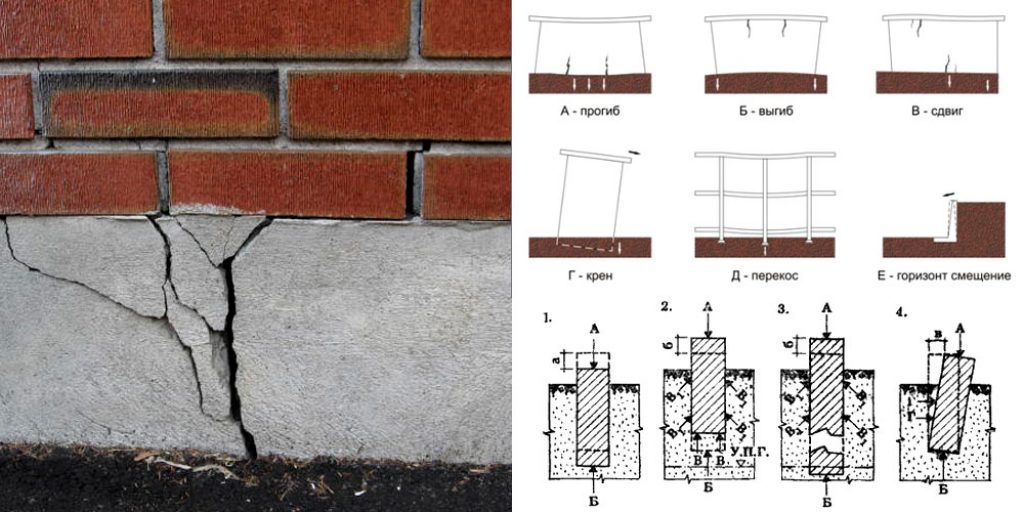
In practice, unreasonably little attention is paid to the survey of the base. Builders are limited to adherence to technology at the construction stage, and tracking of further structure behavior is ignored. At the same time, it is the deformations of the foundations that lead to the most significant destruction, up to complete collapse. The most difficult and difficult to eliminate deformations are associated with foundations and foundation soils.
The procedure and methodology for examining foundations and foundations
A certain methodology has been developed for conducting an examination of the foundations of buildings in order to determine its condition and timely identify defects and errors. Specialists engaged in such examinations begin their work with the laying of special pits.
The locations and depths of these pits depend on the design of the structure, the characteristics of the soil, the category of complexity and the safety of the future building. The main task is to determine the strength of the concrete underground. Additionally, soil samples are extracted on which the foundation is laid. They are subjected to laboratory research, and a detailed report is drawn up describing the characteristics of the soil. To obtain the necessary soil, the pits are torn off below the base of the foundation.
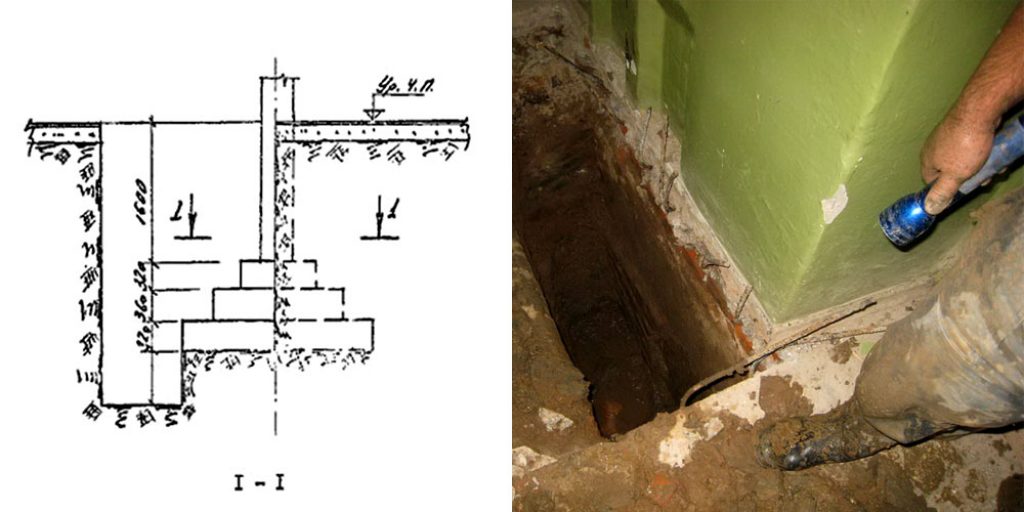
Depending on the object, the foundation can be of different types:
- Ribbon (solid and discontinuous)
- Columnar (glass, pile)
- Solid (slab for the entire perimeter of the building)
During the initial survey, significant deformations and damage to the foundation can be detected. In this case, an instrumental examination is performed.
In this case, experts conduct tests of cores from structures - this allows them to compile a complete picture of the strength parameters of the element. In addition, a non-destructive examination of the foundation is carried out using special methods and instruments, during which cracks of various degrees of opening are revealed. Experts must definitely establish the reasons for their appearance.
The main parameter that is determined and analyzed when examining foundations, both existing buildings and newly erected ones, is the strength of concrete. Its definition is an obligatory task for the employee.
There are several methods for establishing the exact strength of concrete in a foundation:
- Non-destructive testing (while the concrete structure is not exposed to mechanical stress and damage)
- Ultrasound examination with a special tester
- Elastic rebound
- Shock pulse method
- Chipping-off method
- Study on a special press of selected design samples
- An important method is laboratory analysis of selected soil samples
The choice of a suitable method for examining the foundation is determined by the characteristics of a particular object and the technical capabilities of the performers.

Based on the results of the complex of measures taken, a detailed technical report is drawn up. It should contain the following information:
- List of the defective state of the foundation
- Complete data on damage, settlement and foundation defects
- Detailed results of analysis of cores and chips in the laboratory
- Parameters obtained during the instrumental examination
- Detailed assessment of the strength of the base
- Final conclusions on the examination and a list of recommendations for builders
Conducting a foundation survey requires special attention from specialists to all details. In the course of the work, several stages are distinguished:
- Preparatory stage (collection of basic data, study of documentation, selection of survey methods)
- Field work stage (direct survey of the object in nature, collection of relevant information)
- Stage of laboratory analyzes and research
- Cameral stage (generalization of the collected materials, analysis and preparation of a technical report)
Now in more detail about each of these stages.
The preparatory stage of the foundation survey
At this obligatory stage, the specialists are faced with the task of collecting the maximum of available data on the construction object, including design documentation, a description of the production technology, a passport for materials, etc.
The whole stage includes:
- Analysis and preparation of project documentation
- Compilation of materials for engineering-geological, hydrogeological studies, which fully describe the object and area in question
- Development and maintenance of logs of observations of rolls, settlements, deflections and other deformations occurring with the foundation
- Development and implementation of a complex of engineering actions at the construction site
Already at the preparatory stage, specialists carry out constant control and monitoring of a building or structure in order to promptly identify defects.
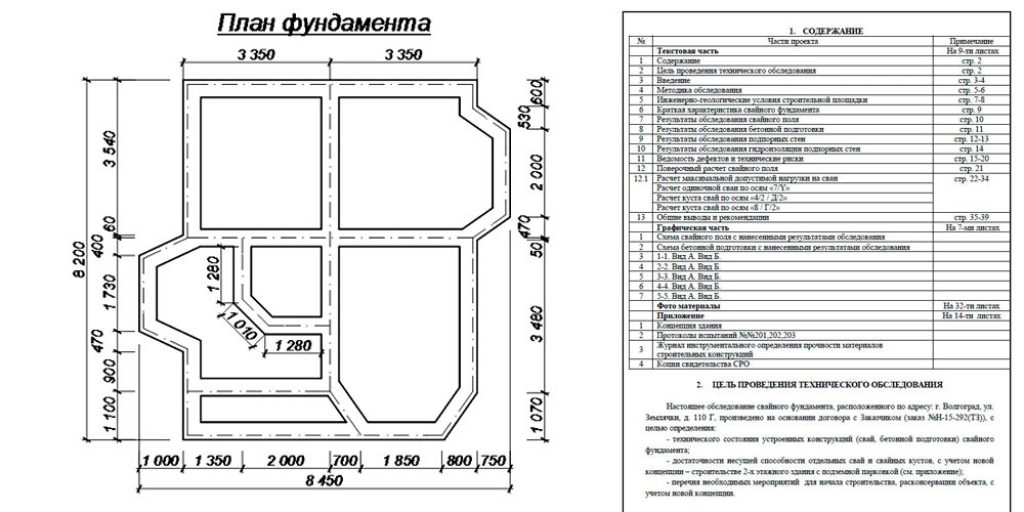
A full-fledged preparatory stage makes it possible to establish the need for opening the foundation. If individual fractions are washed out in the soils, then work on opening the foundations can lead to complete destruction. If in the course of the survey some sediment is detected above the permissible level, then statistical sounding of the soils is performed.
Field work
The most important stage for collecting up-to-date information about the object and quick decision-making in a specific situation. It includes the following works:
- After analyzing the settlement in the work area, upon admission, special survey pits are laid. After the opening, the employee conducts a full analysis of the condition of the underground part of the structure. Here it is necessary to study the state of waterproofing of foundations, the technical condition of the structure, the strength of materials. A thorough inspection is carried out for cracks and damage. Based on the results of the work in the pits, a detailed technical report is drawn up.
- With the help of special tools, samples are taken for subsequent examination in laboratory conditions. Sampling points are determined additionally in accordance with the recommendations and rules for examining foundations.
- At the field stage, specialists carry out instrumental identification of deformations of the ground part of the structure. When establishing their presence, one should identify the cause of the appearance and make recommendations for its elimination.
Complex of laboratory works
The list of laboratory work includes actions to study selected samples using appropriate equipment in order to identify the actual parameters of the sample. At this stage, the workers are faced with the task of accurately determining the physical and mechanical characteristics of the structure, as well as the properties of the research object in terms of strength and deformation changes. All stages of work and possible results are described in detail in the relevant GOSTs and instructions.
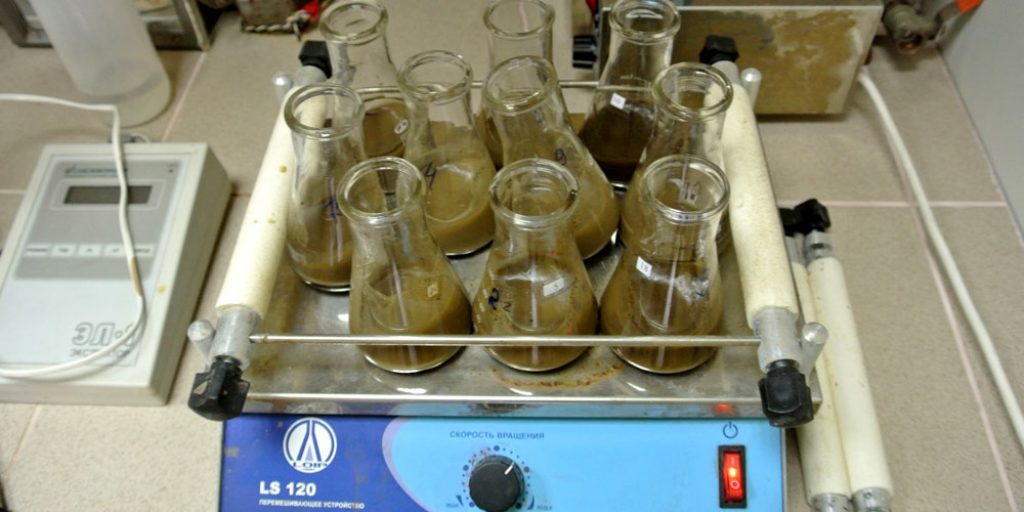
Particular attention is paid to the analysis of sampled cores of the soils lying at the base of the foundation. Soil characteristics determine the likelihood and amount of settlement under the influence of the structure. For an optimal result with sufficient accuracy, the rules for sampling and the order of their analysis are determined.
Cameral work
At the final stage of the foundation survey, the contractor is faced with the task of summarizing the work carried out and drawing up a detailed report on the object, with full description the current state of the structure and recommendations for subsequent work.
Specialists who carry out surveys of foundations and foundations have broad powers to organize construction. If the foundations are found to be inconsistent with the regulatory requirements, they can suspend construction until the above remarks are eliminated. If necessary, an additional examination can be carried out.
Methods for determining the strength of concrete when examining foundations
Determining the strength of the concrete used in the construction of the foundation is a key task during the survey. To establish the characteristics of the material in practice, there are several different methodswhich are divided into several groups
- Destructive methods
- Direct non-destructive
- Indirect non-destructive
Their separation is based on mechanical action on concrete. When selecting best method are based on a specific object and its characteristics, as well as on the available equipment.
Destructive methods are classical and require the analysis of the laid foundation in situ, using mechanical action. The most popular and considered to be an accurate method is the method of determining strength by testing samples taken from the structure. Despite the accuracy, over time, this method is used less and less. The reason lies in the undesirability of even minimal mechanical damage to foundations.

Each material has its own passport with a description of the factory characteristics. Concrete is divided into several classes, and for a specific object, the required calculated class is described in the design documentation. Deviation from the class is unacceptable, as it violates all design calculations. In laboratory conditions, the technology for determining the class of concrete is extremely simple: on a specially designed hydraulic press, the concrete cubes under study are crushed. The strength index obtained during the experiment determines the class of the material.
On this moment The best way to inspect a foundation is to use non-destructive analysis methods. With the help of special devices, ultrasonic radiation of the required wavelength is created, which, passing through the concrete, is captured by the receiver. This is how specialists get all the necessary characteristics of the material.
In what cases are foundations surveyed
The main reasons for the need for a foundation survey are as follows:
- Requirements of the safety class of the facility being erected, which prescribe mandatory inspection of foundations
- Identification of defects in the structure that could be provoked by the foundation
- Additional reinforcement of the existing structure
In the latter case, the survey is preceded by construction works... The need for this arises in the case of:
- Erection of additional floors of the building
- Installation of process plants and equipment
- With mechanical wear of the existing foundation
In all cases, the development of a project to strengthen the foundation is required, which is impossible without a detailed analysis of the existing structure.
Factors affecting the technical condition of foundations
Foundation like underground part structures, directly interacts with soils. Therefore, before laying the foundation, the characteristics of the soil are studied. Settlement and fluctuations in the structure of the foundation can lead to significant destruction of the foundation. The interaction with soil is a key factor affecting the condition of the foundation of a structure.
The foundation is exposed to external influences environment: temperature drops, both daily and yearly, lead to micro-destruction of the material structure and reduce its strength. This is primarily caused by the expansion of moisture inside the foundation.
In some situations, the foundation is exposed to unusual influences. These include earthquakes, underground work, and cavity formation. In areas with possible seismic events, the foundation production technology has a number of features.
The constant impact of a large load of the weight of the entire object on the foundation requires periodic monitoring of its condition.
Inspection of a monolithic foundation
The main load from all ground parts of buildings and structures is borne by the foundation, which is the main bearing element of the entire structure, distributing its weight evenly over the entire base. For this reason, especially durable materials (stone, concrete, wood) are used for its manufacture.
The choice of material depends on the seismicity of the zone, the soil of the area, the architectural design of the structure. If a large building is being erected, then a tape, pile, columnar, slab or glass type of foundation is chosen, and low buildings are placed with a slight deepening.
Due to the design features of this part of the buildings, their sensitivity to the action of groundwater, vibration loads, soil mobility, it is necessary to periodically inspect the foundations. Such measures make it possible to determine their real technical condition, the degree of wear and tear, and the ability to withstand excess loads.
Complex studies of foundations and soils of foundations should be trusted only by professional experts who have permits for appraisal activities. The specialists of the Constructor company, who have extensive experience in this area, will carry out an examination, help determine the cause of deformations and develop recommendations that will solve all your difficulties.
Why is it important to inspect foundations
Various deformations in the foundation and foundation of objects can manifest themselves in different periods - both during its construction and during the operation of the building. This usually happens if the construction was carried out in violation of the standards, which were not recorded in time, and the causes of the damage were not eliminated.
Foundations and foundation soils belong to the hidden part of structures. The inability to visually observe their condition and the lack of concern of building owners about the inspection of these important parts of the structure leads to the appearance of various defects in them and even the destruction of the entire object for these reasons. Therefore, it is important to examine the components of the foundation in time, especially if reconstruction of buildings is planned, for example, when additional floors are built on them.
Such surveys are carried out with the involvement of specialists from an independent expert organization. The customer of this service should determine to what volume of research the foundation and the soil base on which it is located will be subjected. He prepares terms of reference for independent experts, where he indicates for what purpose he is going to conduct them. Most often, studies are ordered in connection with the planned overhaul of the building or its reconstruction, as well as in the event of the danger of an emergency or in connection with the discovery of any damage.
The TK specifies the list of examinations required to be carried out at this facility, provides links to regulations, according to which the survey of the specified facility should be conducted. At the end of the assignment, experts are instructed to make a conclusion on the results of the research and give recommendations on how to eliminate the problems found.
Preparatory stage of the survey
After signing the contract for the provision of the "foundation survey" service with the customer, the experts carry out it in stages, starting with preparatory work, external inspection, instrumental verification and ending with conclusions about the actual state of the specified structure.
At the preliminary stage, experts carry out the following activities:
- consider the design and executive documents of the investigated structure;
- study materials on previous surveys (engineering-geological, hydrogeological);
- view reports related to geophysical, seismological studies;
- study technical diagnostics with information about the available various deformations of the building;
- analyze information related to utilities, planning of facilities, the results of previous studies of the foundation and soil.
Foundation expertise
Special pits are made near the foundations to be examined, the depth of which is about half a meter below the level of the sole. The number of pits and their sizes depend on the parameters, the shape of the structures, soil conditions, and the survey task. If there are basements in this building, pits are made from its inside to reduce the amount of work with the soil. First carried out visual examination foundations.
During it, fixation is performed:
- dimensions, type of foundation, depth of its soil immersion;
- gaps between the edge of the bottoms and the foundation;
- deformations of the concrete surface in the form of cracks, chips;
- violations of the protective concrete layer due to corrosion processes in the reinforcement;
- displacement of reinforced concrete blocks from their location relative to the axis of the building;
- various subsidence, faults, deformations of the base soil.
At this stage, the terrain that surrounds the structure, as well as its ground structures, is examined. Waterproofing is checked, or its absence is noted, the level of groundwater is estimated. These inspections make it possible to find the cause of the damage, and by the type of ground structures to reveal the nature of the foundation defects. At the end of the visual inspection, a report is made indicating the damage to reinforced concrete structures with their detailed description and location.
After that, an examination of the foundations is carried out using special tools. The strength of concrete is determined by ultrasonic or sclerometric methods (non-destructive testing). During the instrumental study, the concrete is checked for water resistance, frost resistance, and the degree of corrosion. The valve and its parts are checked for damage. And also all loads are calculated that affect the edge of the foundation, including the dead weight of structures along with technological equipment.
Base soil survey
In the pits prepared during the study of the foundation, an inspection is also carried out subgrade... To assess its condition, exploratory wells are drilled in them, after which samples of soil and groundwater are taken to determine their main characteristics in laboratory conditions.
Expert opinion
After conducting surveys in various ways of the foundation with soil, the information that was obtained during the work is processed and systematized. An expert opinion is drawn up. It is a statement with a detailed report on all types of damage to these building components. An assessment of the main characteristics of the foundation and soil is given, data from instrumental studies are presented.



